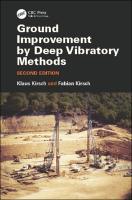Ground Improvement by Deep Vibratory Methods
| dc.contributor.author | Kirsch, Klaus | |
| dc.contributor.author | Kirsch, Fabian | |
| dc.date.accessioned | 2022-02-18T16:57:14Z | |
| dc.date.available | 2022-02-18T16:57:14Z | |
| dc.date.issued | 2017 | |
| dc.identifier | ONIX_20220218_9781482257571_7 | |
| dc.identifier.uri | https://library.oapen.org/handle/20.500.12657/53006 | |
| dc.description.abstract | Vibro compaction and vibro stone columns are the two dynamic methods of soil improvement most commonly used worldwide. These methods have been developed over almost eighty years and are now of unrivalled importance as modern foundation measures. Vibro compaction works on granular soils by densification, and vibro stone columns are used to displace and reinforce fine-grained and cohesive soils by introducing inert material. This second edition includes also a chapter on vibro concrete columns constructed with almost identical depth vibrators. These small diameter concrete piles are increasingly used as ground improvement methods for moderately loaded large spread foundations, although the original soil characteristics are only marginally improved. This practical guide for professional geotechnical engineers and graduate students systematically covers the theoretical basis and design principles behind the methods, the equipment used during their execution, and state of the art procedures for quality assurance and data acquisition. All the chapters are updated in line with recent developments and improvements in the methods and equipment. Fresh case studies from around the world illustrate the wide range of possible applications. The book concludes with variations to methods, evaluates the economic and environmental benefits of the methods, and gives contractual guidance. | |
| dc.language | English | |
| dc.subject.classification | thema EDItEUR::T Technology, Engineering, Agriculture, Industrial processes::TN Civil engineering, surveying and building::TNK Building construction and materials | en_US |
| dc.subject.classification | thema EDItEUR::T Technology, Engineering, Agriculture, Industrial processes::TN Civil engineering, surveying and building | en_US |
| dc.subject.classification | thema EDItEUR::T Technology, Engineering, Agriculture, Industrial processes::TN Civil engineering, surveying and building::TNC Structural engineering::TNCC Soil and rock mechanics | en_US |
| dc.subject.other | backfill | |
| dc.subject.other | column | |
| dc.subject.other | columns | |
| dc.subject.other | compaction | |
| dc.subject.other | concrete | |
| dc.subject.other | depth | |
| dc.subject.other | material | |
| dc.subject.other | replacement | |
| dc.subject.other | stone | |
| dc.subject.other | vibro | |
| dc.title | Ground Improvement by Deep Vibratory Methods | |
| dc.type | book | |
| oapen.identifier.doi | 10.1201/9781315372341 | |
| oapen.relation.isPublishedBy | 7b3c7b10-5b1e-40b3-860e-c6dd5197f0bb | |
| oapen.relation.isbn | 9781482257571 | |
| oapen.relation.isbn | 9781482257564 | |
| oapen.relation.isbn | 9780367139025 | |
| oapen.relation.isbn | 9781315372341 | |
| oapen.imprint | CRC Press | |
| oapen.pages | 252 | |
| peerreview.anonymity | Single-anonymised | |
| peerreview.id | bc80075c-96cc-4740-a9f3-a234bc2598f1 | |
| peerreview.open.review | No | |
| peerreview.publish.responsibility | Publisher | |
| peerreview.review.stage | Pre-publication | |
| peerreview.review.type | Proposal | |
| peerreview.reviewer.type | Internal editor | |
| peerreview.reviewer.type | External peer reviewer | |
| peerreview.title | Proposal review | |
| oapen.review.comments | Taylor & Francis open access titles are reviewed as a minimum at proposal stage by at least two external peer reviewers and an internal editor (additional reviews may be sought and additional content reviewed as required). |

